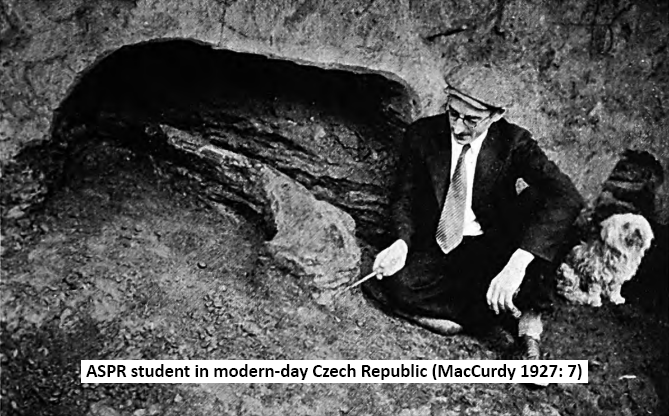Mission & Vision
The American School of Prehistoric Research (ASPR) is a distinct and independent Department housed within the Peabody Museum of Archaeology and Ethnology focused on Old World Prehistoric Research. The ASPR was formed in 1925 and incorporated in 1926 in New York City. Funds were accumulated through private donations to this fund and managed independently by ASPR through the death of George Grant MacCurdy in 1947, at which point Harvard University accepted stewardship of the ASPR resources and its continued management under the direction of the ASPR board with a focus on prehistoric research in the Old World and education in connection therewith through lectures, publications, and exhibitions.
In 1954, the ASPR was transitioned into its current status as a Department of Old World Prehistory in the Peabody Museum. In 1983, the will of Mrs. Janet MacCurdy endowed the ASPR with additional financial resources, a portion of which was annually dispersed to Ms. MacCurdy until her death in 1990. The terms of her will explicitly state that the mission of the ASPR is to foster research, teaching and publication on archaeological studies of Old World Prehistory. In particular, the will clearly enumerates the purposes for which the funds can be spent: cooperation in prehistoric research with Old World institutions, organizations and scholars, including providing fellowships to bring scholars to research, study and consult at Harvard, lectureships by Old World scholars, and support for publications on related topics. The endowment has been used to support researchers, students, publications, and exhibits, but not on collections or curation.
Scope of Research
The ASPR supports research and education in old world prehistory. For the purposes of our department, the old world is considered any area outside of the North and South American continents, and prehistory is defined as time periods before written records. If you are unsure if your research fits with our mission, see below to learn more about the scope of projects that we support.
The Context of the ASPR’s Foundation

The American School of Prehistoric Research was founded in February 1921 and officially incorporated five years later. During this time and in the period between the two world wars more generally, much of the prehistoric research taking place in Europe was not effectively reaching audiences on the other side of the Atlantic, and George Grant MacCurdy, the founder of the organization and a prehistoric archaeologist with extensive connections to the leading European scholars in his field, was uniquely poised to bridge this gap. In fact, in his description of the ASPR’s foundation he recounted that a few colleagues had suggested:
…that a school of prehistoric studies, somewhat after the plan of our American Schools of classical studies in Athens, Rome and Jerusalem, might be established in France. This to me is not a new idea, for ever since my student days in Europe, I have been hoping to see a prehistoric link formed that would bind the New World to the Old World. (MacCurdy 1946: 150)
When Human Origins, MacCurdy’s nearly 1,000 page magnum opus, was published in 1924, it would have been for many Americans “the richest source of information available on palaeoanthropology, a field for which the primary literature was inaccessible to many” (Bricker 2002: 277)
The school’s first field season began in France on July 2nd, 1921, and for the next 16 years, at least 116 students participated in the program’s annual trips to Europe, which always featured a myriad of activities including excavation, visits to museums, meetings with foreign specialists, and attendance of academic conferences. MacCurdy was the primary director of field seasons until 1931 when, at age 68, he passed the responsibility on to a former student.

The tradition of taking American students to Europe to give them first-hand experience in prehistoric archaeology did not survive the second world war. The 15th bulletin, which contains a description of the 1938 summer term, was published in 1939; the next bulletin did not come out until 1948, and after that point the ASPR field seasons never looked quite the same. However, the organization was clearly born out of a desire to bridge a scholarly gap and reveal the antiquity of humanity to American audiences. As a component of this mission, the School was devoted to training U.S. students in the field of prehistory and giving them unparalleled first-hand access to archaeological sites, museum collections, and the knowledge of local specialists. Nearly a century later, the needs of the field have changed dramatically, but knowing Mr. MacCurdy’s motivations for founding the ASPR can allow us to move forward with his mission in mind.
References cited
Bricker, H. M. (2002). George Grant MacCurdy: An American Pioneer of Paleoanthropology. In D. Browman, S. Williams, T. A. Barnhart, J. Kelly, B. Borque, and D. M. Oestreicher (Eds.), New Perspectives on the Origins of Americanist Archaeology. The University of Alabama Press.
MacCurdy, G. M. (1946). It Happened in my Lifetime. [Unpublished manuscript].
